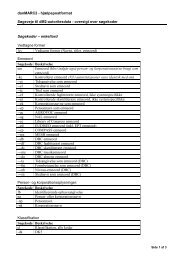RFID Data Model for Libraries - biblstandard
RFID Data Model for Libraries - biblstandard
RFID Data Model for Libraries - biblstandard
You also want an ePaper? Increase the reach of your titles
YUMPU automatically turns print PDFs into web optimized ePapers that Google loves.
<strong>RFID</strong> <strong>Data</strong> model <strong>for</strong> libraries Doc 067<br />
through the security gate, the detection system checks this code. If the code indicates,<br />
"Checked out", nothing happens. If the code indicates, "Checked in”, an alarm goes off.<br />
This process of checking the code needs to occur rapidly, especially when multiple items are<br />
present. Generally, that means that you would not want the system to have to read the code on<br />
each individual tag because that could take too long if a patron was carrying several items.<br />
An approach is to use a method that will result in tags only responding if the item has NOT<br />
been checked out. If no tag responds, there is no alarm. If even one tag responds with "not<br />
checked out", then there is an alarm.<br />
There are a number of different ways to do this. Philips, <strong>for</strong> example, has "EAS bit" capability<br />
built into a portion of their tag memory. When a reader issues an "EAS" command, the tag<br />
responds if it has not been turned off properly.<br />
It can be observed that the EAS command is not a required part of standard ISO 15693-3 and<br />
that it will not necessary be supported by all ISO 15693-3/ISO 18000-3 Mode 1 tags.<br />
AFI method<br />
Some other library vendors use a different tag function, called the AFI (Application Family<br />
Identifier) function. This function is commonly supported in ISO 15693-3 tags, as the AFI is a<br />
specified part of the standard.<br />
There is the necessity of two AFI’s <strong>for</strong> a security system. One value indicates “Checked out”<br />
another value indicates “Checked in”. The typical functionality is as above: The system calls<br />
<strong>for</strong> tags with the AFI value “Checked in”. If any responds then the alarm starts.<br />
There is a location in the systems part of the memory in the tag to hold the AFI. The standard<br />
is not specifying too much about this method.<br />
A general remark<br />
New items arriving to the library from media vendors should - if they have active <strong>RFID</strong> tags<br />
mounted - the values <strong>for</strong> security should be set <strong>for</strong> “Checked in”.<br />
Conclusion<br />
The working group has had discussions on the desirability of having a unique security method<br />
<strong>for</strong> a multitude of cooperating libraries. The conclusion is that this can not necessarily be<br />
achieved if each library has the freedom to choose a system from the range of suppliers<br />
without excluding suppliers with one or another method <strong>for</strong> security system.<br />
It will be desirable that general AFI values are to identify the library sector. If such values are<br />
achieved they can be used <strong>for</strong> identifying the library sector. And they can also be used <strong>for</strong><br />
security. Systems not using AFI <strong>for</strong> security should use the AFI value <strong>for</strong> “Checked out” to<br />
avoid confusion.<br />
Apart from this security issues are a part of the <strong>RFID</strong> data model <strong>for</strong> libraries<br />
23




